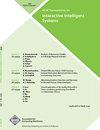XAutoML:用于理解和验证自动机器学习的可视化分析工具
IF 4.8
4区 计算机科学
Q2 COMPUTER SCIENCE, ARTIFICIAL INTELLIGENCE
引用次数: 2
摘要
在过去的十年里,人们提出了各种自动化机器学习(AutoML)系统来构建端到端的机器学习(ML)管道,而人工交互最少。尽管这种自动合成的ML管道能够达到有竞争力的性能,但最近的研究表明,由于AutoML系统缺乏透明度和对构建的ML管道缺乏解释,用户不信任AutoML构建的模型。在对36名领域专家、数据科学家和AutoML研究人员的需求分析研究中,我们收集了AutoML的详细信息需求,这些专家来自不同的行业,在ML方面的专业知识差异很大。我们提出了一个交互式可视化分析工具XAutoML,用于解释任意AutoML优化过程和由AutoML构建的ML管道。XAutoML将交互式可视化与来自可解释人工智能(XAI)的成熟技术相结合,使整个AutoML过程透明且可解释。通过将XAutoML与JupyterLab集成,有经验的用户可以使用基于从XAutoML提取的信息的特别可视化来扩展可视化分析。我们在一个用户研究中验证我们的方法,该研究使用来自需求分析的相同的不同用户组。所有参与者都能够从XAutoML中提取有用的信息,从而大大提高了对AutoML生成的ML管道和AutoML优化本身的理解。本文章由计算机程序翻译,如有差异,请以英文原文为准。
XAutoML: A Visual Analytics Tool for Understanding and Validating Automated Machine Learning
In the last ten years, various automated machine learning (AutoML) systems have been proposed to build end-to-end machine learning (ML) pipelines with minimal human interaction. Even though such automatically synthesized ML pipelines are able to achieve competitive performance, recent studies have shown that users do not trust models constructed by AutoML due to missing transparency of AutoML systems and missing explanations for the constructed ML pipelines. In a requirements analysis study with 36 domain experts, data scientists, and AutoML researchers from different professions with vastly different expertise in ML, we collect detailed informational needs for AutoML. We propose XAutoML, an interactive visual analytics tool for explaining arbitrary AutoML optimization procedures and ML pipelines constructed by AutoML. XAutoML combines interactive visualizations with established techniques from explainable artificial intelligence (XAI) to make the complete AutoML procedure transparent and explainable. By integrating XAutoML with JupyterLab, experienced users can extend the visual analytics with ad-hoc visualizations based on information extracted from XAutoML. We validate our approach in a user study with the same diverse user group from the requirements analysis. All participants were able to extract useful information from XAutoML, leading to a significantly increased understanding of ML pipelines produced by AutoML and the AutoML optimization itself.
求助全文
通过发布文献求助,成功后即可免费获取论文全文。
去求助
来源期刊

ACM Transactions on Interactive Intelligent Systems
Computer Science-Human-Computer Interaction
CiteScore
7.80
自引率
2.90%
发文量
38
期刊介绍:
The ACM Transactions on Interactive Intelligent Systems (TiiS) publishes papers on research concerning the design, realization, or evaluation of interactive systems that incorporate some form of machine intelligence. TIIS articles come from a wide range of research areas and communities. An article can take any of several complementary views of interactive intelligent systems, focusing on:
the intelligent technology,
the interaction of users with the system, or
both aspects at once.
 求助内容:
求助内容: 应助结果提醒方式:
应助结果提醒方式:


